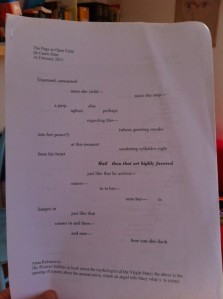A post about another enjoyable and interesting poetry workshop devised and delivered by Carrie Etter, made possible by Hilda Sheehan and Bluegate Poets, at The Richard Jeffries Musuem, near Swindon.
In The Page as Open Field we read and discussed six poems which use the page in a non-linear, unconventional way, with text not necessarily starting at the top left-hand side of the paper and not always running from left to right and from the top to bottom of the page. For instance, we looked at the poem pictured below, by Anna Rabinowitz, (seemingly untitled, although text in the centre of the page was emboldened, so this could be considered the title) taken from her collection The Wanton Sublime (a book about the mythologies of the Virgin Mary).

The text, arranged on the page this way, suggested the shape of an angel (this particular poem was about the Annunciation, when the Angel Gabriel appears to Mary).
We also read Three Geese by Susan Stewart, the text of which replicates the shapes made by geese flying in formation then coming in to land on water, and Patched by Mark Dickinson which (among other things) makes closely observed details about clouds in small fragments of text, all in italics, dotted over the page as clouds are in the sky.
Another poem we looked at was Wordoku (pictured below) by Ira Lightman, with its text printed inside a sudoku grid

and we also read Hurts Me Too by John Burnside and Divination by Catherine Hales.
A lively and interesting discussion followed the readings. Some of us enjoyed the playfulness of, for instance, Wordoku and liked the way it suggested an alternative way of engaging with rules and what rules mean; we felt stimulated, excited, confused, intrigued in varying measures. Some people liked the playfulness but didn’t feel satisfied – they weren’t sure if engaging in playfulness was enough for them, or was what they wanted from poetry. Some felt the poems were more about form than content. Some felt irritated by the unconventional layout. We discussed which subjects lent themselves to, for instance, a shape poem, and we agreed that it seemed appropriate that Three Geese and Patched mimicked the shapes found in nature, and the subject matter of the poems.
With this in mind,the next part of the workshop was to venture outside, with our notebooks, into the gardens of the Museum to make detailed observations about our surroundings. The gardens are very pretty – the snowdrops are out, the daffodils just beginning, the shrubs and trees just about to bud – but the M4 motorway isn’t far away and although the bird calls were insistent and crystal clear, the over-riding soundtrack was of the relentless cars. They certainly featured in my observational details!
When we came back inside, Carrie gave us each a blank sheet like this:

so that we could begin to transpose the notes we’d made outside into a poem, using the page as an open field. Carrie asked that we start somewhere other than the top left hand corner. This threw several of us and I began to feel quite outside my comfort zone – a good thing! Starting half way down the page, somewhere towards the right, made me write a different opening line to the one I thought I’d write. I wrote in a completely different way to the way I usually write and I think that, regardless of whether I want to write this way, I would use this “grid method” as a way into drafting a poem. A great workshop exercise, I think.
One of the loveliest things about The Page as Open Field was that the woman next to said that she’d written a poem all across the page when she was a young child at school and she’d been told that she wasn’t allowed to do this! She felt liberated to create and play in this way and her happiness was wonderfully contagious!
Thanks Carrie, Hilda and Bluegate Poets for a super day in lovely Swindon.

How interesting! I’ve never played around with the space on a page before. Something to try!
LikeLike
Thanks for commenting, Isabel! It did make me think about words in a completely fresh and different way.
LikeLike
Space on the page is always interesting. How poets use it to control the flow of words. Sounds like a great session.
Jim
LikeLike
It was great fun to work this way. I’m not sure that I would like to read a whole book written that way, though. Thanks for commenting!
LikeLike
I love this post. I’m eccentric and I paint as well as write. I use paper any way I want to. Right side up or upside down but this posts opened me up to some new possibilities. Writing in grids using words to craft shapes is now on my list of things to try. Thank you.
LikeLike
How lovely that you’re going to try something new! I’m so pleased you enjoyed the post and thanks for saying so.
LikeLike